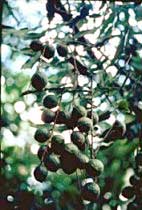|
|
|
Nut
trees

Photo © Australian National Botanic
Gardens
Although nut and fruit trees are generally
grown in horticultural systems, some of the larger growing nut
tree species produce high quality timber. Pecan, chestnut and
walnut trees can be incorporated into extensive, multipurpose
farm forests for timber, nuts, shade and beautification. Managing
nut trees so they might also provide high value timber may reduce
the risks associated with uncertain nut prices.
Because of their wood quality and growth habit, achieving a
short, straight, branch-free log of around two metres might
be all that is required for a high value sawlog. This can be
done by carefully form pruning the tree when young to encourage
it to grow straight then removing the lower branches once it
is well established. Where the Persian or English walnut (Juglans
regia) is grafted to a black walnut (Juglans nigra) rootstock
the butt log can include an attractive mix of colours at the
point where the two species meet.
Back to top
|
